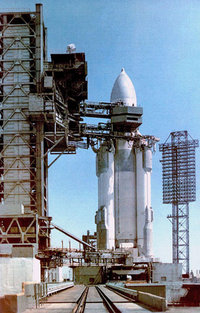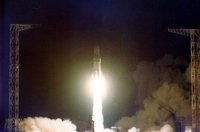Energia
|
|
Energia_pad_01.jpg
The Energia (or Energiya, Энергия in Russian) rocket was a Soviet craft that was designed at TsAGI to serve as a heavy-lift expendable launch system as well as a booster for the Buran Space Shuttle. It had the capacity to place up to 100 metric tons in low Earth orbit, although it could be configured for heavier payloads comparable to (or even greater than) those of Saturn V. It was first test-launched in 1987 with the Polyus spacecraft (UKSS military payload), where the Energia itself functioned well, but the Polyus failed to reach orbit due to a malfunction of its own attitude control system after separation from Energia. The only other flight to orbit has been the successful mission in which the unmanned Buran orbiter (space shuttle) was brought to orbit, in 1988.
Energia exceeded both the payload capability and the technical performance of the Saturn V, earning itself the status of the most complex and powerful heavy rocket ever constructed. The immense costs of developing the Energia and the Buran systems are, according to many analysts, one of the many reasons for the Soviet Union’s economic collapse. (Note that this refers to the development costs, not to the running costs of operating Buran/Energia.) Both the Energia and Buran programs were designed as part of the backbone itself of the maintenance of strategic parity between the two superpowers.
Work on the Energia/Buran system began in 1976 after the decision was made to cancel the unsuccessful N-1 superbooster. The cancelled N-1 rocket-based Manned Lunar Launch Facilities and Infrastructure were used for Energia. The N-1 was capable of putting 95 metric tonnes into LEO and was powered by 30 Kuznetzov NK-15 engines developing 1,544 kilonewtons (kN) thrust each for a total of 46 meganewtons (MN) (10.2 million pounds-force), thus far exceeding the US Saturn V at 33 MN (7.5 million pounds-force) lift-off thrust. It also replaced the "Vulkan" concept, which was a design based on the Proton rocket and using the same toxic hypergolic fuels, but much larger and more powerful.
There were three major variants planned past the flown configuration, each with vastly different payloads. The Energia M was the smallest design configuration. The number of Zenit boosters was reduced from four to two, and instead of four RD-0120 engines in the core, it had only one. It was designed to replace the Proton rocket, but lost the 1993 competition to the Angara rocket. The Energia-2 was designed to be completely reusable. While the Zenit boosters were always designed to be reused, the core would be expended in each launch. With the Energia-2, the core would be capable of re-entering and gliding to a landing, presumably using technology developed for the Buran. The final unflown configuration was also the largest. With eight Zenit booster rockets and an Energia-M core as an upper stage, the "Vulkan" (which was interestingly the same name of another Soviet heavy lift rocket that was cancelled years earlier) or "Hercules" configuration could have launched a stunning 175 tonnes into orbit.
The Energia rocket only flew twice, the first on May 15 1987, with the UKSS military payload, and the second on November 15 1988, with the Buran Shuttle. Production of Energia rockets ended with the fall of the Soviet Union and the end of the Buran shuttle project. Ever since, there have been persistent rumors of the renewal of production, but given the current market realities, that is highly unlikely.
The grounding of the US space shuttles has caused many to wonder aloud whether or not the Russian Energia launcher or Buran shuttle could have been brought back into service. However, the reality of the situation is that all the equipment for Energia and Buran, including the vehicles themselves, have either rotted away or been repurposed since falling into disuse with the collapse of the Soviet Union.
Energia lives on, in a sense. The four strap-on liquid-fuel boosters, which burned kerosene and liquid oxygen, were the basis of the Zenit rocket which used the same engines. The engine is the RD-170, a powerful, modern and efficient design. It is still used on the Baikonur-launched Zenit and on the Sea Launch floating launch platform system, which is built around the Zenit. A less powerful derivative of the engine, the RD-180, powers Lockheed Martin's Atlas V, one of the two new U.S. EELV rockets (the other being the Boeing Delta IV).
The company S.P. Korolev Rocket and Space Corporation Energia is still in business.
See also
External links
- Encyclopedia Astronautica: Energia (http://www.astronautix.com/lvs/energia.htm)
- Official energia.ru page (http://www.energia.ru/english/energia/launchers/vehicle_energia.html)
- K26 Energia page (http://k26.com/buran/index.html)
de:Energija ja:エネルギア pl:Energia (rakieta) ru:Энергия (ракета-носитель) fr:Energia



